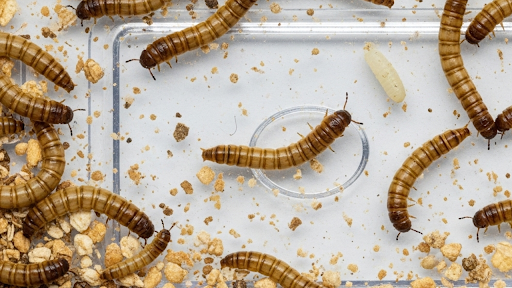How Mealworms Can Help Reduce Environmental Impact
Mealworms offer an exciting and natural way to support a healthier planet. They’re eco-friendly, efficient, and can transform waste into valuable resources. However, our environment faces growing problems caused by excessive waste and pollution:
- Food waste piling up in landfills producing harmful greenhouse gases
- Plastic pollution choking oceans and landscapes
- High environmental costs of traditional livestock farming
- Resource depletion from overused land and water
These issues threaten ecosystems and our future. Here, we will dive into how mealworms can help reduce environmental impact by tackling these challenges with sustainable solutions.Here we will discuss how these lworms help in reducing environmental impact.
1. Breaking Down Organic Waste
These worms naturally feed on grains, decaying leaves, and other organic material. This makes them excellent decomposers in nature. When used to consume food scraps or agricultural waste, these worms help divert these materials from landfills, where they would otherwise decompose and release methane — a potent greenhouse gas.
Methane emissions from landfills are a major contributor to climate change, so reducing organic waste in landfills is crucial. By breaking down food waste quickly and efficiently, these worms can significantly reduce the volume of trash and slow the production of harmful gases. This natural recycling process turns waste into valuable biomass, helping close the nutrient loop.
2. Eating Plastic Waste
One of the most exciting recent discoveries is that these worms can digest certain types of plastic, specifically polystyrene foam, also known as Styrofoam. This type of plastic is commonly used in packaging and is notoriously difficult to recycle or break down, persisting in the environment for hundreds of years.
These worms’ ability to consume and biologically break down Styrofoam offers a promising solution to plastic pollution. When these worms eat Styrofoam, bacteria in their gut help degrade the plastic into simpler, less harmful compounds. While research is ongoing, this unique trait suggests these worms could become part of innovative waste management strategies to tackle plastic pollution in oceans and landfills.
3. Sustainable Protein Source
They are rich in protein and healthy fats, making them a nutritious feed option for pets, livestock, and potentially humans. Compared to traditional livestock farming, producing worms requires far less land, water, and energy. For example, raising cattle demands large areas of grazing land and significant water resources, which contribute to deforestation and water scarcity.
These worms, on the other hand, can be farmed indoors on small plots with minimal resources, making them a more sustainable protein choice. Incorporating worms into animal feed can reduce the environmental costs associated with conventional protein production, helping to conserve natural resources and lower greenhouse gas emissions.
4. Less Greenhouse Gas Emissions
Mealworm farming produces significantly fewer greenhouse gases than livestock farming. Cattle and pigs generate large amounts of methane and nitrous oxide, which have a much higher warming effect than carbon dioxide.
They produce minimal greenhouse gases, making them an eco-friendly alternative protein source. Choosing these worms over traditional meat can therefore be an effective way to reduce one’s carbon footprint and fight climate change.
5. Efficient Use of Resources
They are incredibly efficient at converting food waste and agricultural by-products into high-quality protein. They can thrive on leftover grains, vegetable scraps, and other organic waste materials.
This ability to recycle waste into nutrition reduces the demand for additional crops grown specifically for animal feed, which often require pesticides, fertilizers, and irrigation. By feeding on organic waste, these worms also help reduce the volume of discarded food, minimizing landfill buildup and associated environmental issues.
Conclusion
These worms present a powerful, natural solution to several environmental challenges. By breaking down organic waste, digesting plastic, and serving as a sustainable protein source, they help reduce landfill mass, cut greenhouse gas emissions, and conserve precious resources. Understanding how long does a mealworm beetle lives also helps optimize their farming for continuous benefits. Their low environmental footprint compared to traditional livestock makes them a smart choice for the future of food and waste management. Embracing mealworm farming and incorporating these tiny decomposers into sustainable practices can significantly lower our ecological impact and support a healthier planet for generations to come.

